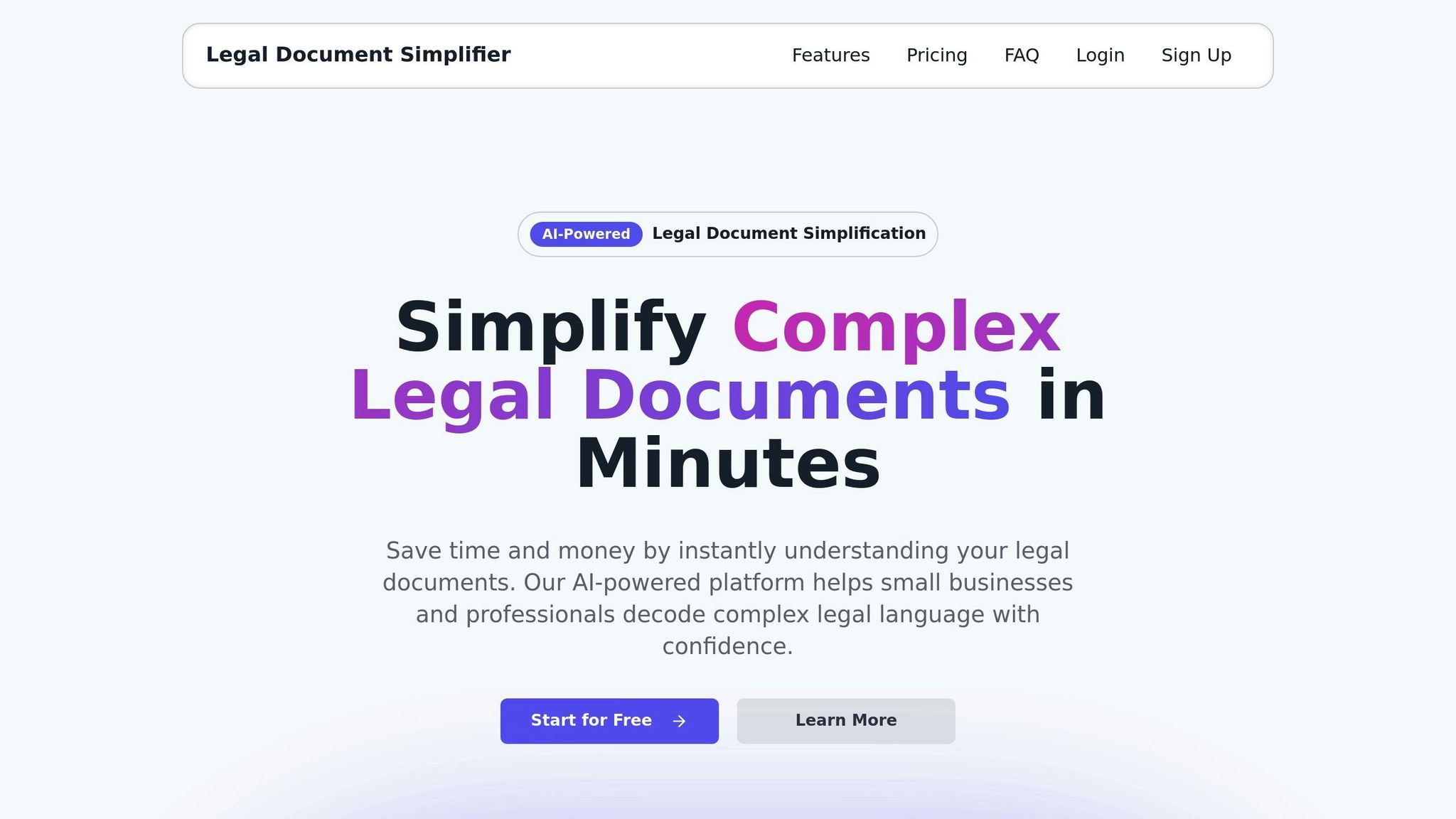
Business Contract Review Checklist: 10 Essential Steps
Reviewing business contracts can be overwhelming, but a structured checklist simplifies the process. Here are the 10 key steps to ensure your contracts are clear, compliant, and aligned with your business goals:
- Verify Party Details: Confirm legal names, addresses, and signatories.
- Understand Contract Purpose: Check goals, deliverables, and scope.
- Confirm Dates and Deadlines: Ensure timelines, milestones, and notice periods are accurate.
- Examine Payment Terms: Review amounts, schedules, and dispute handling.
- Define Rights and Responsibilities: Clarify obligations and performance standards.
- Assess Exit and Renewal Terms: Understand termination and renewal clauses.
- Evaluate Risk and Liability: Review indemnification and liability limits.
- Check Privacy and Data Rules: Ensure compliance with data protection laws.
- Review Dispute Resolution Terms: Confirm arbitration or mediation guidelines.
- Understand Change Procedures: Verify amendment and notification processes.
Pro Tip: Use AI tools like Legal Document Simplifier to speed up reviews by up to 80%. These tools simplify legal jargon, flag risks, and streamline workflows.
Contract Review Checklist [Top Tips for Contract Review]
Before You Start
Laying the groundwork before diving into a contract review is essential. Getting organized upfront reduces errors and makes the entire process smoother. Gather your documents, double-check critical details, and assemble a team to ensure a strong start.
Collect Required Documents
Make sure you have all the necessary paperwork for a complete review:
- The main contract itself
- Any referenced exhibits and schedules
- Additional documents like specifications or service level agreements
- Previous versions of the contract (if it's a renewal)
- Email correspondence discussing contract terms
Check Basic Information
Verify the key details of the contract to avoid simple but costly mistakes:
- Full legal names and addresses of all involved parties
- Effective date and expiration terms
- Jurisdiction and governing law
- Payment terms and amounts
- Properly completed signature blocks and authority confirmation
This initial review helps catch any obvious issues that could cause problems down the line.
Assign Review Team
Having the right team in place ensures a thorough and efficient contract review. Include members with specific expertise:
| Role | Responsibilities |
|---|---|
| Contract Manager | Coordinates the process and manages deadlines |
| Legal Counsel | Reviews for compliance and assesses risks |
| Subject Matter Expert | Checks technical requirements and deliverables |
| Financial Reviewer | Analyzes payment terms and financial details |
| Operations Lead | Evaluates implementation and feasibility |
Set aside dedicated time for each member to review and provide feedback. Each team member should document their observations and recommended changes, creating a clear record to guide negotiations. This methodical approach ensures nothing is overlooked.
10-Step Contract Review Process
Follow these steps to protect your business interests and ensure the contract meets your needs. Carefully go through each step for a thorough review.
1. Verify Party Details
Make sure all involved parties are accurately identified. Check:
- Full legal business names
- Physical and mailing addresses
- Registration numbers
- Authorized signatories
- Contact details for key personnel
2. Understand Contract Purpose
Review the contract’s goals and scope to confirm they align with your objectives. Focus on:
- Deliverables and expectations
- Performance metrics
- Quality requirements
- Timelines
- Scope limitations
3. Confirm Dates and Deadlines
Establish a clear timeline by reviewing:
- Start date and conditions
- Key milestones
- Payment schedules
- End date
- Notice periods for any changes
4. Examine Payment Terms
Pay close attention to:
- Payment amounts and how they’re calculated
- Payment schedules
- Procedures for handling invoice disputes
- Penalties for late payments
- Policies for expense reimbursements
5. Define Rights and Responsibilities
Clearly outline each party’s obligations, including:
- Service or product details
- Performance standards
- Reporting requirements
- Quality benchmarks
- Support and maintenance terms
6. Assess Exit and Renewal Terms
Understand how the contract can be ended or extended. Look into:
- Termination notice periods
- Automatic renewal clauses
- Early termination rights
- Post-termination responsibilities
- Transition assistance requirements
7. Evaluate Risk and Liability
Focus on how risks are shared by reviewing:
- Indemnification clauses
- Limitation of liability terms
8. Check Privacy and Data Rules
Ensure the contract addresses data protection by reviewing:
- Data handling procedures
- Security measures
- Breach notification requirements
- Confidentiality duration
- Steps for returning or destroying data
9. Review Dispute Resolution Terms
Make sure the contract includes clear processes for resolving disputes, such as:
- Arbitration or mediation guidelines
10. Understand Change Procedures
Confirm how changes to the contract will be handled. Check for:
- Amendment processes
- Rights to assign or transfer responsibilities
- Subcontracting permissions
- Change order protocols
- Notification requirements for modifications
sbb-itb-a9520de
Using Legal Document Simplifier

Legal Document Simplifier uses AI to make contract review faster and easier by translating complex legal language into plain terms, all while keeping the original intent intact. It works seamlessly with a structured review checklist, helping users save time and effort.
Main Tools and Functions
The standout feature of Legal Document Simplifier is Plain Language Translation, which transforms legal jargon into straightforward, easy-to-understand business language.
Time and Cost Savings
By replacing manual contract review with AI-powered tools, Legal Document Simplifier significantly reduces the time and effort required:
| Aspect | Traditional Review | With Legal Document Simplifier |
|---|---|---|
| Processing | Manual review | AI-driven instant analysis |
| Language Clarity | Requires legal expertise | Automatic simplification |
| Document Handling | Up to 10 per month (Basic) | Up to 50 per month (Professional) |
Available Plans
Legal Document Simplifier offers flexible plans to suit different contract review needs:
| Plan | Monthly Cost | Document Limit | Key Features |
|---|---|---|---|
| Basic | $29 | 10 documents | AI simplification, basic support |
| Professional | $79 | 50 documents | Priority support, advanced features |
| Enterprise | Custom | Unlimited | Dedicated manager, full customization |
All plans include the core AI simplification tool. The Professional plan is a great fit for businesses managing multiple contracts each month. For larger organizations with unique needs, the Enterprise plan offers tailored solutions, including a dedicated account manager and custom features.
Conclusion
A well-organized contract review checklist is key to safeguarding business interests and ensuring agreements are legally sound. Pairing this structured approach with modern technology enhances both accuracy and efficiency in managing contracts.
AI-powered tools like Legal Document Simplifier can significantly cut down review times without sacrificing precision. In fact, 82% of businesses now consider AI systems a priority for transforming financial workflows. Combining these steps with AI-driven insights streamlines the process and improves accuracy.
Legal Document Simplifier simplifies complex legal language into clear, actionable terms while addressing critical review steps. The platform identifies risks, compliance issues, and hidden terms that manual reviews might overlook. By merging a structured review process with advanced AI tools, businesses can achieve faster results while ensuring strong legal safeguards.
FAQs
How can I confirm that everyone signing a contract has the authority to legally bind their organization?
To confirm signing authority, request documentation such as a board resolution or a written statement verifying the signer’s authority. Double-check that the individual’s title and name match official records and ensure they are authorized to act on behalf of their organization. Taking these steps helps prevent disputes and ensures the agreement is legally binding for all parties.
What are the key risks businesses should watch for when reviewing contract terms?
When reviewing contract terms, businesses should be mindful of several key risks that could impact operations, finances, or reputation. Financial risks may include penalties for missed deadlines, unexpected automatic renewals, or warranty claims. Legal risks can arise from poorly worded clauses, non-compliance with laws, or breaches that could lead to disputes or lawsuits.
Additionally, security risks are a concern, such as storing contracts in unsecured locations or using unencrypted communication methods. Reputation risks may stem from terms that could harm brand perception or employee morale. Lastly, operational risks like errors in data entry or inadequate contract management processes can disrupt business efficiency. Carefully reviewing these areas can help mitigate potential issues and protect your business.
How can AI tools like Legal Document Simplifier make contract reviews faster and more accurate compared to traditional methods?
AI tools, such as Legal Document Simplifier, streamline contract reviews by quickly scanning and analyzing documents, identifying critical clauses, obligations, and potential risks in a fraction of the time it takes using manual methods. This allows legal teams to handle more contracts efficiently while focusing on high-priority tasks.
By minimizing human error, AI enhances accuracy and ensures compliance with organizational policies. It can also reference past contracts to flag unenforceable language or inconsistencies, providing instant insights that would otherwise require time-consuming manual searches. With these capabilities, AI tools not only save time but also improve the reliability and effectiveness of contract reviews.